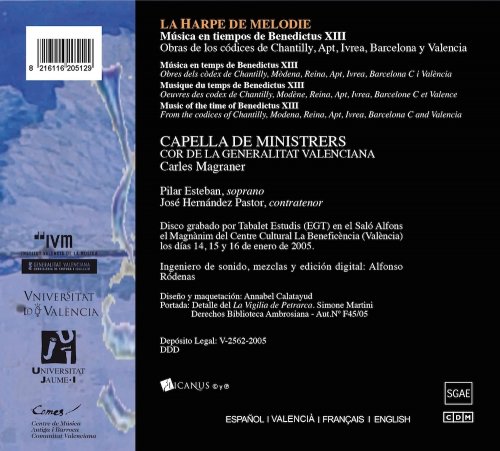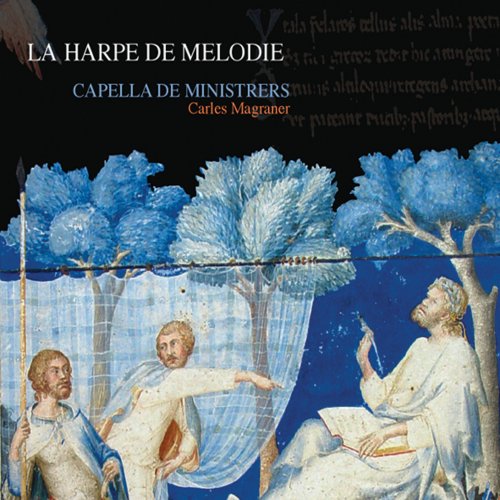
Capella De Ministrers, Carles Magraner - La harpe de melodie (2005)
BAND/ARTIST: Capella De Ministrers, Carles Magraner
- Title: La harpe de melodie
- Year Of Release: 2005
- Label: CDM
- Genre: Classical
- Quality: flac lossless (tracks)
- Total Time: 01:02:21
- Total Size: 327 mb
- WebSite: Album Preview
Tracklist
01. La harpe de melodie
02. Puis que je suis fumeux
03. Je voy le bon tens venir
04. Adieu vous di
05. Ma douce amour
06. Fuions de ci
07. En ce gracïeux tamps joli
08. Kyrie. Rex angelorum/ Clemens pater
09. Gloria
10. Credo
11. Sanctus. Sanans fragilia
12. Agnus
13. Apollinis eclipsatur/ In omnem terram/ Zodiacum signis
14. Degentis vita/ Cum vix articidi/ Vera pudicitia
15. Gaude flori virginali

Music from the times of Benedict XIII (the Papa Luna—an antipope) is the subtitle of this recording containing works from the codex of Chantilly, Apt, Ivrea, Barcelona and Valencia. Essential for those devoted to the music of the late Middle Ages.
The time of Benedict XIII, Pope Luna, which covers more or less from the middle of the XIV century to the beginning of the XV, is the new center of interest of the celebrated Capella de Ministrers group, directed by Carles Magraner. In this autumn of the Middle Ages there is just the flowering of the Ars nova, from the famous treatise by Philippe de Vitry that establishes a new system of musical notation and with it greater harmonic and rhythmic variety in the composition, greater expressivity, and also of the Ars subtilior, which takes to the limit the harmonic complexities and the possibilities of dissonance, turning the text into an intellectual conundrum of thick symbolism. Of course, not all of these advances were to the liking of the Church, which would eventually forbid the new style for its avant-garde and lightness.
Although Guillaume de Machaut is the most overwhelming creator of the period, the true star of the Ars Nova, some of his followers showed themselves capable of writing beautiful compositions, as evidenced by the present program that drinks codices like those of Chantilly, Apt, Ivrea, Barcelona and Valencia. We can enjoy the ballads and virelais of Jacob de Senleches (whose piece entitled La Harpe de melodie gives the album its title), Johannes de Janua or Jehan Simon de Haspre and Jaquet de Noyon, as well as other anonymous authors. But we are also offered, for example, the Missa coram Papa, made from fragments of various anthologies, or the beautiful hymn Gaude flori virginali, contained in the Cantoral of the Poor Clares of Valencia.
The Capella de Ministrers, with the collaboration of the Cor de la Generalitat Valenciana, proposes a sober but vivifying interpretation of this repertoire, in which it stands out, in the instrumental, it is a percussion of marked Arabic aroma and, in the vocal, the beautiful timbres of the soprano Pilar Esteban and the countertenor José Hernández Pastor.
01. La harpe de melodie
02. Puis que je suis fumeux
03. Je voy le bon tens venir
04. Adieu vous di
05. Ma douce amour
06. Fuions de ci
07. En ce gracïeux tamps joli
08. Kyrie. Rex angelorum/ Clemens pater
09. Gloria
10. Credo
11. Sanctus. Sanans fragilia
12. Agnus
13. Apollinis eclipsatur/ In omnem terram/ Zodiacum signis
14. Degentis vita/ Cum vix articidi/ Vera pudicitia
15. Gaude flori virginali

Music from the times of Benedict XIII (the Papa Luna—an antipope) is the subtitle of this recording containing works from the codex of Chantilly, Apt, Ivrea, Barcelona and Valencia. Essential for those devoted to the music of the late Middle Ages.
The time of Benedict XIII, Pope Luna, which covers more or less from the middle of the XIV century to the beginning of the XV, is the new center of interest of the celebrated Capella de Ministrers group, directed by Carles Magraner. In this autumn of the Middle Ages there is just the flowering of the Ars nova, from the famous treatise by Philippe de Vitry that establishes a new system of musical notation and with it greater harmonic and rhythmic variety in the composition, greater expressivity, and also of the Ars subtilior, which takes to the limit the harmonic complexities and the possibilities of dissonance, turning the text into an intellectual conundrum of thick symbolism. Of course, not all of these advances were to the liking of the Church, which would eventually forbid the new style for its avant-garde and lightness.
Although Guillaume de Machaut is the most overwhelming creator of the period, the true star of the Ars Nova, some of his followers showed themselves capable of writing beautiful compositions, as evidenced by the present program that drinks codices like those of Chantilly, Apt, Ivrea, Barcelona and Valencia. We can enjoy the ballads and virelais of Jacob de Senleches (whose piece entitled La Harpe de melodie gives the album its title), Johannes de Janua or Jehan Simon de Haspre and Jaquet de Noyon, as well as other anonymous authors. But we are also offered, for example, the Missa coram Papa, made from fragments of various anthologies, or the beautiful hymn Gaude flori virginali, contained in the Cantoral of the Poor Clares of Valencia.
The Capella de Ministrers, with the collaboration of the Cor de la Generalitat Valenciana, proposes a sober but vivifying interpretation of this repertoire, in which it stands out, in the instrumental, it is a percussion of marked Arabic aroma and, in the vocal, the beautiful timbres of the soprano Pilar Esteban and the countertenor José Hernández Pastor.
As a ISRA.CLOUD's PREMIUM member you will have the following benefits:
- Unlimited high speed downloads
- Download directly without waiting time
- Unlimited parallel downloads
- Support for download accelerators
- No advertising
- Resume broken downloads


